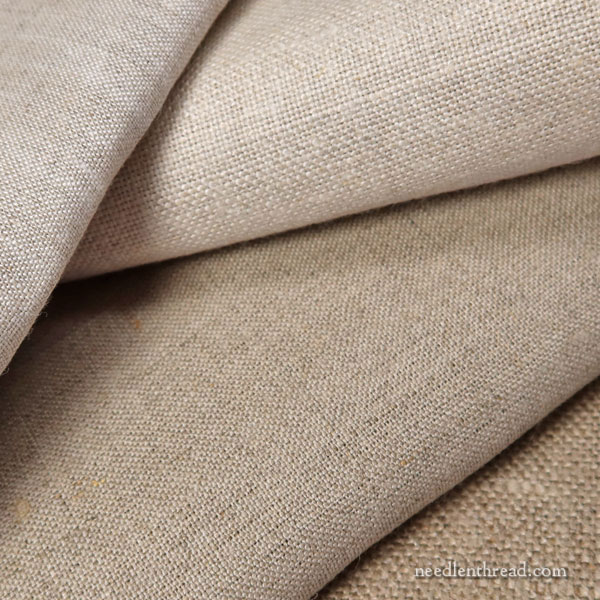Happy Monday! Woohoo! The beginning of another week. I hope it’s going to be a great one for all of us!
If you’ve been hanging about with me on Needle ‘n Thread for a wee bit, you probably know that I’m a sucker for linen. It is by far my favorite fabric – not just for embroidery, but pretty much for everything.
Linen, made from flax, has been around since the beginning of written history and earlier. It’s the oldest excavated fabric.
It’s beautiful. It’s versatile. It’s rough. It’s fine. It’s sacred. It’s secular. It’s elegant. It’s casual. It’s long-wearing, warm, cool, heavy, light. It’s the stuff of heirlooms.
Linen, in short, is Awesome!

I like to geek out on linen (though, admittedly, not as much as other people I know … you know who you are!).
Part of that geeking out includes exploring the linen industry as much as I can from the middle of Kansas – which means mostly online. Here in Kansas (especially southeast Kansas) flax crops have always been for seeds and seed oil. Where I live in northeast Kansas, flax is also grown for its flowers, for visual pleasure. It grows well, scattered like a wildflower.
But Let’s Talk Linen
Sometimes, the topic of linen fabric can be a bit confusing.
In needlework, we often hear about thread count and weave when referring to linen. Is it a plain weave or an even weave? Is it a high thread count or a low thread count?
But for other uses – for example, in the sewing world – we talk about fabric weight, weaves, and finishes. Is it lightweight linen (like linen batiste) or is it heavy weight (like upholstery linen)? Is it softened (sanforized)? Is it a blend? Is it shot?
There’s a lot to learn about linen – and really, fabric in general!
The Lowdown on Linen Weights
By way of a really good article on the Sartor website, I thought I’d help you learn a little bit about linen weights.
I think this is a great article for understanding what it means when you see a weight next to a commercial description of linen. What does it mean when it says that a certain linen is “3 oz”? This article will tell you.
How does this relate to needlework? Well, the more you know about how different fabrics are explained and described, the better you’ll be at making good choices in fabric.
And while we don’t normally classify needlework linen by weight (at least here in the US), understanding the terminology about linen weights (and other fabric terminology) can help you make informed decisions about the fabric you choose for needlework.
I hope you enjoy the article!







Ooh, thank you, Mary! And I have to share this rather new to me source of linen.
Fabrics Store
Yeah, sort of dumb name, but they say their linen has a non-wrinkling treatment! They seem to be Ukranian! Founded in 1998 by Nikolai Karpushin. They have a blanket, towel and robe fabric that draws up into puffy squares when washed. And they’re headquartered in the U.S. Some of their customers have done hand embroidery on special garments. Oh, maybe I’m the last to know about this! I still have to pre-wash my first blouse length.
I have used some of their fine white linen as backing fabric behind my ground fabric, for certain types of embroidery. It’s not a favorite linen – I would not use it on any “serious” needlework project as the actual ground fabric, but it works ok as a backing linen, and it is inexpensive, relatively speaking. It really cannot hold a candle to the much better quality Italian linens and Belgian linens sold for needlework. The linen shown in this article: https://needlenthread.wpengine.com/2017/05/exploring-linen-origin-quality-uses.html is from them. I bought various weights to test. I could see using some of it as toweling, perhaps, once it’s been washed and washed and washed – it shrinks quite a bit, and it sheds a ton of lint at first.
It looks as if the autumn fire kits have sold out again, already? I was hoping to do it in silk, but I shall go ahead and work it in DMC, and it will still be beautiful!
Yes, they sold out a little more quickly than I realized they would. I don’t think we will have a chance to put together more over the next few weeks, but I do plan to keep them stocked, if possible, so we should have more in the not-too-distant future.
Hi Mary, Thank you for the link to the informative article on the Sartor site. I’m still trying to figure this out – it’s confusing when everything is remote over the web rather than walking into a store and seeing/feeling fabrics in person. Is the ‘Autumn Fire’ blue linen a medium weight (151-200 gsm) sanforized linen? Did it come from Sartor (I would like to buy more in order to further practice the tree? Thanks!!!
The blue linen for Autumn Fire is from Ulster Linen Company. I don’t know if it is sanforized – I don’t believe it was in the description, but it may be pre-washed. Usually, sanforized linen (or other natural fibers – like cotton) is more expensive, if it’s truly sanforized and not simply pre-washed. There’s a whole extra and time-consuming process behind sanforization.
Sartor Bohemia is having a 50% off sale Dec 1 -8 — I just went hog-wild. Silk and linen. Postage costs more than fabric. 2m minimum